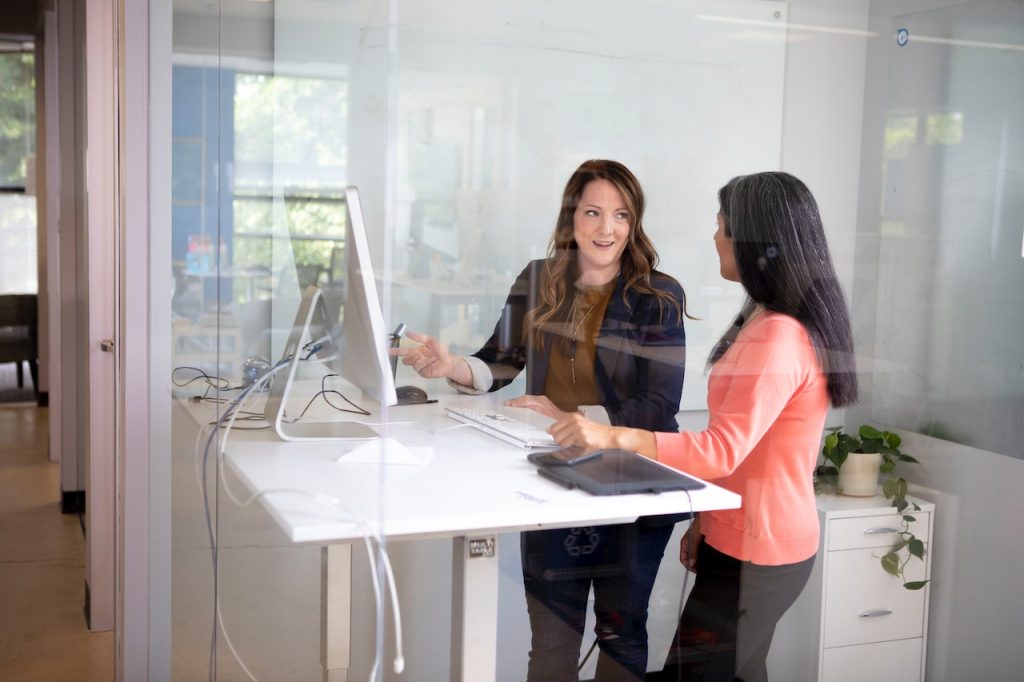Do you experience aches and pain in your shoulders, neck, fingers, or back while working at your desk? Do you often find it hard to focus and feel fatigued? While there are a variety of reasons you may be feeling this way, you may be experiencing these issues due to poor office ergonomics. Poor office ergonomics, including behaviors such as using a keyboard and mouse with improper posture, can lead to pain and discomfort. The good news is there are simple adjustments such as bike desks, chair pads, and standing desks that you can get to improve your office ergonomics.
Office ergonomic practices involve optimizing your office space for better productivity, comfort, and health. This includes the placement of your equipment, how you sit, how you interact with your equipment, and more. As mentioned previously, minor adjustments in these areas can produce excellent results.
Let’s take a look at crucial ergonomic changes you can make to your office space today to increase your productivity and produce a
healthier work environment.

Contents
Find a Comfortable Office Chair That Supports Your Spine
If you’re unsure your current chair supports your spine, there’s a test you can do. First, take a seat in your chair at your desk. Next, press your back into the backrest. Does your lower and mid-back feel cushioned? Are there any gaps between the chair and your spine?
A good office chair supports the natural curve of your back; poorly designed chairs feel like you’re sitting against a hard wall or on a log. You need lumbar support if the chair doesn’t support your lower back. When you spend long periods of time at your desk every day, investing in an office chair with lumbar support is worth it. When your muscles aren’t supported properly, they can become tense and lead to tension headaches in the neck and back of head. This can lead to extreme discomfort and pinched nerves.
Move and Stretch Every Hour
The human body was not made to sit for long periods of time; that’s why we experience aches and nerve pain. Ergonomists recommend taking brief, frequent breaks. You should take a minimum of one break every hour. During these breaks, you should take the time to complete stretch exercises.
If you feel silly exercising in front of your desk or find you don’t have the time, something as simple as standing up or flexing your muscles every 30 minutes can also be helpful. Simply moving will change your posture and bring blood flow to areas of your body that were previously still.
Use a Desk That’s at the Proper Height
When using a mouse and keyboard, your wrists and arms must be in a neutral position; they should be angled down towards your lap or parallel to the floor to reduce strain. Most desks are between 28 and 30 inches tall. These are a good fit for those who are about 5′ 10″ or taller. However, the average adult is shorter than this making most desks not the right fit.
The good news is you can do a few things to fix this. You can mount a keyboard tray underneath your desk if your keyboard needs to be lower than where it generally rests. If you can’t install any hardware, try raising your chair so that your wrists are above the keyboard.
However, if you do need to raise your chair, your feet must stay flat on the floor. If you cannot, you should invest in a footrest to ensure you do not experience additional pain and discomfort.
Switch Between Sitting and Standing
Too much sitting or standing is not good for your body. The best thing you can do throughout the workday is to alternate between the two positions.
However, how long should you sit and how long should you stand for best results? The perfect ratio between sitting and standing lies between 1:1 to 1:3. At a minimum, you should stand for at least 30 minutes, and at a maximum, you should stand for 45 minutes every hour.
A standing desk is always a great choice, but these can be expensive. If you would like to use a standing desk but can’t afford to replace your current desk, you can look into purchasing a desk riser. Desk risers allow you to turn your existing desk into a standing desk.
Find a Mouse That Fits Your Hand
Both constant keyboard and mouse use can cause pain or fatigue. Using repetitive motions can stress the muscles in your wrists and fingers. That’s why carpal tunnel is so common amongst those who work a desk job.
Finding a mouse that fits your hand’s size and shape is essential. Any mouse will do as long as it has a comfortable grip and is maneuverable. Trackball mice are popular among those with shoulder issues because the mouse remains stationary, and a ball works to control the cursor.
Pay Attention to Your Posture
While employing all of the ergonomic tools above is great for providing comfort and making the workday easier, they won’t do much to help your pain if your posture is incorrect. You must remove everything from your pockets before sitting down — including your phone, wallet, and keys. These items tend to put extra pressure on your muscles if kept in the pocket.
Additionally, to correct your posture, you should:
- Distribute your weight evenly on both hips.
- Sit with your back straight.
- Make sure your knees are at a 90-degree angle.
- Leave a small gap between your thighs and the edge of the seat.
- Make sure your feet rest flat on the floor.
- Stand and move around often. Don’t stay in the same position for more than 30 minutes.
The Bottom Line
Whether you work in a small office space, an ample office space, or at home, you must have an ergonomically sound place to work. Many companies are improving the areas they provide their employees, but it’s up to you to ensure you’re taking proper care of your body. For example, a standing desk or an ergonomic mouse are great tools, but they’re not going to help much if you have poor posture and are slumping over your desk.
The Daily Buzz combines the pursuit of interesting and intriguing facts with the innate human desire to rank and list things. From stereotypical cat pictures to crazy facts about the universe, every thing is designed to help you kill time in the most efficient manner, all while giving you something to either laugh at or think about!
